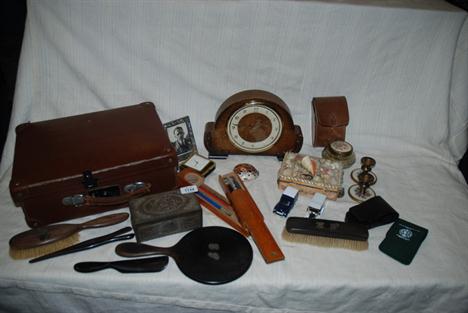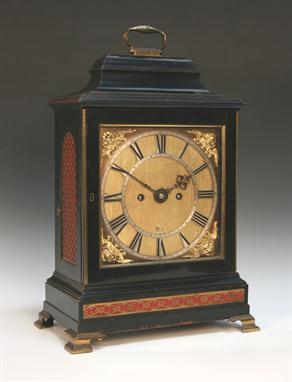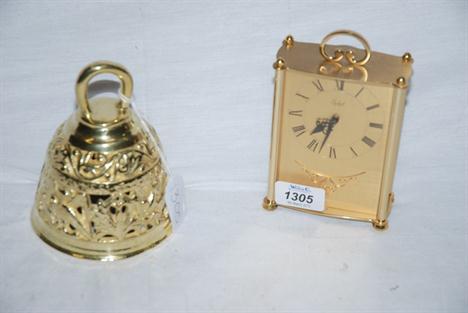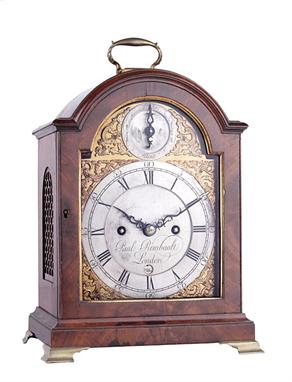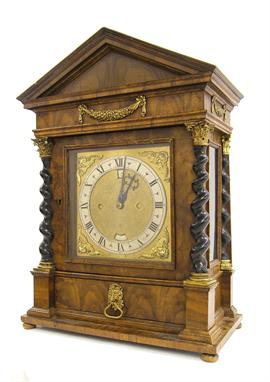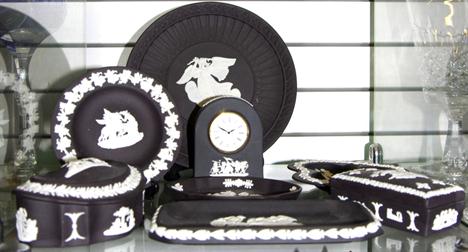We found 10269 price guide item(s) matching your search
There are 10269 lots that match your search criteria. Subscribe now to get instant access to the full price guide service.
Click here to subscribe- List
- Grid
-
10269 item(s)/page
CONTINENTAL LAQUERED BRASS TABERNACLE TABLE CLOCK 19TH CENTURY with associated movement, the architectural case with spire finials and surmounted by figure of Thor, the square sides flanked and divided by pilasters, raised on a spreading base with bun feet 38cm high Provenance: Collection of Basil Hodson
FRENCH EBONISED AUTOMATON MANTEL CLOCK BY THARIN OF PARIS 19TH CENTURY the dial signed Tharin A Paris, the rectangular case with applied gilt metal mounts, the white enamel Roman dial within a beaded bezel signed `Charin A PARIS`, the sides with acanthus carved scrolls, on moulded breakfront base with fountain and twin swan mounts, the brass twin drum movement with outside countwheel signed to the backplate `THARIN PARIS`, the case with central moulded and glazed rectangular aperture depicting a musical automaton figural scene of two seated monks and a standing monk about a table within a monastery interior, continental brass musical movement playing a single air, the side of the case with two buttons and a pull cord 52cm wide, 54cm high, 18cm deep
A rare late-17th / early 18th century gilt bronze square table clock probably German, the square hinged case with serpentine top and base, the silvered chapter ring engraved with Roman hour numerals alternated with fleur-de-lys and outer Arabic minutes, the centre and corners with engraved and repoussé shell and foliate decoration, pierced scroll steel hands, one probably replaced, the glazed sides within silvered foliate engraved and paper scrolled borders, enclosing a single fusee movement with baluster pillars, silvered pierced and engraved backcock, silvered regulator disc, striking a bell to the base, raised on shell scroll feet, height 2¾in. (7cm.), 3¼in. (8.25cm.) square.
An English ebonized table clock, late 17th Century and later, the brass latched eight pillar movement with verge escapement striking hours on a large bell and half hours on a smaller bell, the backplate with engraved and calibrated countwheel, tulip engraved corners and inscribed `Gulielmus Clement, Londini Fecit` within a lambrequin surround, the 9½ inch square brass dial with skeletonised silvered chapter ring and black Roman numerals on a matt ground with date aperture, cornered with winged cherub spandrels, the later ebonized bell top case with brass carry handle above pierced brass arched scale fret panels and glazed doors, on a plinth base and brass bracket feet, height approx 54cm (associated movement and case, and alterations).
Mostly plated wares, comprising; a rectangular twin handled gallery tray, a circular salver with a decorated rim, eight circular gilt table mats with two Asprey leather pouches, twelve pairs of fish knives and forks, with a wooden box, a circular faceted glass salad bowl, a twin handled dish, a circular bowl raised on three feet, a circular Quartz clock, a Ronson table lighter and a small jug.
A German mahogany quarter striking eight day table clock by WINTERHALDER & HOFMEIER, C.1900, the 6 1/4 inch dial set with subsidiary dials for strike / silent and slow / fast, the two train movement with deadbeat escapement, the backplate stamped W & H SCH 3, with rise and fall regulation, striking the quarters on two coiled gongs and the hour on one gong, 60cm high (pendulum and key).
A Chinese Striking Table Clock, 19th century, rectangular form with pierced side and front frets, glazed viewing windows to the sides, 7-inch enamel dial with Roman numerals, centre seconds, mounted on the brass surround engraved with foliate scrolls, above dial with character calligraphic panel, twin fusee movement with verge escapement and striking on a bell, backplate with engraved character calligraphic panel, 50cm high 29.01.13, Case with some crack marks in places and small chips to edges, dial with some surface scratches, movement needs cleaning, striking is not working correctly at present.
A Walnut Chiming Table Clock, circa 1890, arched top and urn finial, pierced side sound fret doors, raised on claw feet, 9-inch arched brass dial with a silvered Roman chapter ring, arch with two dials for fast/slow and chime/silent, triple barrel movement with four hammers chiming onto four gongs and a further hammer striking a larger gong for the hours, backplate stamped RMS, 65cm high 29.01.13, Case with some small dents in parts, top side of the case has slightly faded, top urn finial and moulding has come off and needs securing, dial is slightly dirty, movement is dirty and needs cleaning.
A Mahogany Chiming Table Clock, circa 1890, arched case with pierced side sound frets, raised on claw feet, 6-inch silvered Roman chapter ring, two dials in the arch for fast/slow and chime on eight gongs/chime on four gongs selections, triple fusee movement with anchor escapement chiming with eight hammers onto eight gongs, a further hammer striking a larger gong for the hours, movement backplate stamped W&H Sch and numbered 2103, 46cm high 25.01.13, Case with some small dents and scratches in parts, dial and movement look clean, movement looks complete.
A Black Forest Walnut Inlaid Striking Automata Table Clock, stamped S Kamerer Furtwangen, circa 1850, arched case with nicely figured veneers, side opening doors, arch with painted scene of a running dog and hare with automata rocking eyes, 8-inch dial with applied enamel Roman numeral cartouches, twin barrel movement with striking on a gong, the crutch with connecting wire to operate the automata rocking eyes, movement backplate stamped S.Kamerer Furtwangen, 52cm high 28.01.13, Case with some fading to the veneers in parts, some crazing marks and minor dents and scratches, some mouldings, veneers and joints are slightly lifting in parts, front left hand side wooden foot pad has split, dial with some surface scratches and small nibbles around the winding holes, movement looks dirty and needs cleaning, pendulum with suspension spring missing.
A Walnut Striking Table Clock, arched case with brass and ebony inlay, pierced side sound frets, raised on brass ball feet, 7-inch painted dial with Roman numerals and inscribed Barraud Cornhill London 926, twin fusee movement with anchor escapement and striking on a bell, backplate with engraved borders and inscribed Barrauds Cornhill London, secured with brackets, 43cm high 29.01.13, Case has been totally restored, ball feet have been replaced, dial has been totally re-painted, movement looks clean, due to the total restoration of the clock I have not dated this item. Case is heavily restored or is of a later construction.
A Mahogany Striking Table Clock, signed Bethel Jacobs, Hull, circa 1830, arched top case with side carrying handles and pierced sound frets, applied wooden carved mounts and brass inlaid front, 8-inch convex painted dial with Roman numerals, strike/silent selection lever above 12, twin fusee movement with anchor escapement and striking on a bell, backplate signed Bethel Jacobs 7 Whitefriargate, Hull, secured by brackets, 44cm high 28.01.13, Case with cracking in parts and some chips places, back door possibly has been replaced, a piece of moulding has been placed inside the case back surround which the left movement securing bracket locates onto, some new pieces of moulding and veneers have been replaced in parts, front glass is missing front the bezel, dial has been totally re-painted at some time to a high standard, dial surface with somen dirt marks and small scratches, movement looks clean.
An Ebonised Striking Table Clock, signed Willm Rust, Hull, circa 1790, inverted bell top with carrying handle, pierced side sound frets, mask and floral gilt metal mounts to the canted corners, 9-inch arched painted dial with Roman chapter ring, painted gilt floral decoration to the corners and in the arch, arch with fast/slow selection hand, twin fusee movement with anchor escapement and striking on a bell, backplate signed, 60cm over handle 28.01.13, Case with scratches and small dents in parts, front door with some cracks and chips to the veneers and some of the veneers have been repaired, back door slightly bowed and chips around the borders of the door, dial surface has been totally re-painted at some time to a high standard, dial surface with some small crazing marks and minor scratches and a small dirt mark at 3, movement looks clean and complete.
A Regency Mahogany Striking Table Clock, H Smith, York, with chamfered top, side sound frets and carrying handles, brass inlaid front, 8-inch painted convex dial with Roman numerals, twin fusee movement with anchor escapement and striking on a bell, movement backplate engraved to the borders, 54cm high (distressed) 29.01.13, Case is distressed and needs restoration, veneers missing, cracks and chips in places, brass surfaces have all faded, top with mouldings missing to edges, case has discoloured with sunlight damage, top finial is later, dial faded and flaking throughout, movement looks complete, not striking at present, this is a restoration project for someone.
A Mahogany Chiming Table Clock, signed Webster, established 1711, Queen Victoria St, London, circa 1880, inverted bell top with carrying handle and ball finials, scroll and floral pierced side sound frets, bracket feet, 4-3/4-inch dial with Roman numeral chapter ring, dial centre signed, silent/chime and 8 bells/5 gong selection levers, above with fast/slow regulation dial, triple fusee movement with eight hammers chiming onto eight bells and four hammers striking four gongs and a further hammer striking a larger gong for the hours, movement secured with brackets, 43cm high over handle 16.01.13, Case metal mounts are all discoloured to the surfaces with the gilding rubbed, case with some small cracks to the sides and to the top side between the finials, front door is slightly bowed and the lock is missing, back door edge has split and has been repaired but not very well and needs attention, some edges around the inner part of the back door with chips and dents to the door edges, dial has discoloured in parts, movement is dirty and needs cleaning.
A Regency Mahogany Striking Table Clock, in Egyptian Revival Taste, Yeomans, Nottingham, with gadroon pediment and pineapple finial, pierced side sound frets, gilt metal sphinx canted corners, gadrooned feet, 7-inch painted dial with Roman numerals, twin fusee movement with anchor escapement and striking on bell, 49cm high The design of this clock shows the fashion of the Regency period, with furniture influenced by Rome, Greece and Egypt being very much ``en vogue``. The interest in Egypt revival taste dates back to Napoleon`s expedition of 1798, which lead to the publication of Dominique Vivant Denon`s Vogage dans la basse et la haute Egypt in 1802. Furniture in this style was first shown by Sheraton in his Encyclopedia (1804), leading to its increased popularity. 30.01.13, Case surfaces has been cleaned, edges around the case with some small dents and chips, gilt metal has faded, dial has been totally re-painted, movement looks complete and clean.
An Ebonised Striking Table Clock, inverted bell top with carrying handle, side viewing windows, 7-inch arched brass dial with silvered Roman and Arabic chapter ring, matted centre with date aperture and mock pendulum with silvered plaque bearing inscription Jasp Taylor London, arch with strike/silent selection, twin fusee movement with verge escapement and striking on a bell, engraved scrolled backplate inscribed Jasper Taylor Holborn London, movement secured by brackets, 50cm high over handle 28.01.13, Case has been re-ebonised a some time, some moulding around the case have been replaced and cracking to some veneers, right hand side glass panel has broken, some chips to edges and some flaking to the ebonised surfaces in parts and new pieces of wood added, arch with silvered dial faded, movement needs cleaning, striking is functioning, striking side of the movement at the top of the front plate with one vacant hole which is directly in line with a dial foot on the dial plate which has been cut off and filed back. (The dial could have possibly been later added to the movement due to the vacant hole to the movement frontplate).
A Rare Mahogany Quarter Striking Table Clock, signed Eardley Norton, London, No.2723, circa 1770, inverted bell top with pineapple finial, pierced side sound frets, raised on bracket feet, 8-inch arched brass dial with Roman and Arabic chapter ring, inner date ring with corresponding central date hand, signed and numbered to the centre, arch with strike/silent selection, twin fusee movement with verge escapement and quarter striking with two hammers striking onto two bells, backplate engraved with floral and scroll decoration and numbered 2723 to the top right, movement secured with brackets, 65cm high 29.01.13, Case with damage around sound frets and pieces of veneer replaced, veneer to back door is lighter in colour to the rest of the case and could be later added veneer or door, Front door has been restored in parts to the veneers and some small cracks, finials to the inverted top look later added, case surface has been polished, dial with small scratches and the silvering has faded, movement looks complete and striking at present.
A George III Walnut Striking Table Clock, signed Thos Husband, Hull, circa 1780, inverted bell top with carrying handle, side glazed viewing windows, raised on bracket feet, 7-inch arched brass dial with silvered Roman and Arabic chapter ring, matted centre with date aperture and silvered plaque signed, arch with strike/silent selection, twin fusee movement with verge escapement and striking on a bell, backplate engraved with scroll and floral decoration throughout, secured by brackets, 52cm high over handle 28.01.13, Case has faded due to sunlight damage, sides of the case with chips and moulding missing around the glazed viewing windows, dial is faded to the silvered chapter ring, wooden dial surround with chips and pieces of wood missing, movement needs cleaning, movement looks complete and strike work is functioning.
A Fine George III Musical Mahogany Striking Table Clock, signed Willm Mason, London, circa 1770, inverted bell top case, side carrying handles and pierced sound fret opening doors, applied gilt metal mask and floral mounts to the canted corners, raised on bracket feet, 8-inch arched brass dial with silvered Roman and Arabic chapter ring, matted centre with date aperture and signed silvered recessed plaque Willm Mason London, arch with four tune selection dial God Save Ye King/Home Sweet Home/Vicar Of Bray/Tom Bowling, triple fusee movement with anchor escapement, the pinned comb controlling eleven hammers striking a nest of eleven bells for the musical train every hour and followed by a further hammer striking a single bell for the hours, movement backplate engraved with basket, scroll and bird decoration, secured with brackets, 58cm high 27.02.13, Case with some pieces of veneer missing to the door, case with some small dents and crack marks in places, some mouldings around the case with chips and are slightly lifting, some small pieces of veneer has been added later, back door very slightly bowed, dials need re-silvering and brass dial plate needs cleaning, movement needs cleaning, hour striking bell post has broken and not striking on a bell at present, front plate with a small hole which has been plugged next to the anchor arbor pivot, converted to anchor from verge, the musical tunes all appear to be working at present, The home sweet home tune appears to have been added in the early 19th century which the pins to the pinned comb would have had to be slightly re-positioned on the comb.
A Regency Mahogany Striking Table Clock, signed John Moore, Clerkenwell, London, arched top pediment, side sound frets, inlaid brass stringing to the front, raised upon brass ball feet, 8-inch painted dial with Roman numerals, twin fusee movement with anchor escapement and striking on a gong, movement backplate with engraved borders and signed, movement secured by brackets, 43cm high 05.02.13, Case with chips to edges and pieces of moulding missing in parts, inlaid brass to the front has faded and is lifting, dial with the painted surface flaking in parts and with scratches, movement looks dirty and needs cleaning.
A George III brass mounted fruitwood quarter-chiming table clock Robert Henderson, London circa 1775 The six pillar triple fusee movement with verge escapement, chiming the quarters on a nest of eight graduated bells and striking the hour on a further larger bell, the backplate engraved with symmetrical strapwork and foliate scrolls around a central basket motif with pendulum holdfast hook beneath, the 7 inch brass break-arch dial with shaped recessed silvered signature plate engraved RobÕt Henderson, London and calendar aperture to the matted centre within applied silvered Roman numeral chapter ring with Arabic five minutes to outer track and scroll pierced blued steel hands, the angles with rococo scroll cast spandrels beneath arch centred with a subsidiary Strike/Silent dial flanked by conforming mounts, the bell top case with scroll pierced frets flanking pedestal surmount capped with a pineapple finial above brass festoon applied collar and four further finials to superstructure, over front with scroll cast upper quadrant frets and fillet inset glazed dial aperture to door flanked by cast female caryatid applied canted angles, the sides with generous hinged carrying handles above conforming concave topped rectangular side windows, on moulded shallow skirt base with foliate scroll cast bracket feet, 58cm (23ins) high overall. Robert Henderson is recorded in Baillie, G.H. Watchmakers & Clockmakers of the World as working in London 1768-1805, Baillie further notes that a musical clock by Henderson is in the ÔPeipingÕ Museum collection.
A George III small mahogany table clock Paul Rimbault, London, circa 1800 The five pillar twin chain fusee bell striking movement signed Paul Rimbault, London to the scroll border engraved backplate, the 6 inch brass break-arch dial with repeat signature and circular calendar aperture to the silvered centre within applied Roman numeral chapter ring with Arabic five minutes to outer track and scroll cast lacquered brass spandrels to angles beneath arch with subsidiary Strike/Silent dial flanked by conforming mounts, the break-arch case with brass carrying handle above brass fillet inset front door aperture and arched brass fishscale sound frets to sides, on moulded skirt base with brass bracket feet, 31cm (12ins) high excluding handle. Paul Rimbault is recorded in Baillie G.H. Watchmakers & Clockmakers of the World as working from Denmark Street, London 1770-85.
A George III ebonised table clock Thomas Pepys, London, circa 1775 The five pillar twin fusee bell striking movement with verge escapement and symmetrical foliate scroll engraved backplate, the 8 inch brass break-arch dial with calendar aperture and shaped recessed silvered signature plaque engraved Thomas Pepys, London to the matted centre within applied silvered Roman numeral chapter ring with Arabic five minutes and scroll pierced blued steel hands, the angles applied with scroll cast spandrels beneath arch centred with subsidiary STRIKE/SILENT dial flanked by conforming mounts, the bell-top case with brass carrying handle above foliate scroll pierced quadrant frets and raised mouldings to dial aperture flanked by caddy moulded angles to front, the sides with circular over concave topped windows, on cavetto moulded shallow skirt base with brass bracket feet, 49cm (19.25ins) high. Thomas Pepys is recorded in Baillie G.H. Watchmakers & Clockmakers of the World as working in London from circa 1740.
A George III mahogany table clock Thomas Crowdhill, London, circa 1790 The five pillar twin fusee bell striking movement with symmetrical foliate scroll engraved backplate and 7 inch silvered brass break-arch Roman numeral dial with calendar aperture and signature Crowdhill, LONDON to centre and Arabic five minutes to outer track, the angles with foliate scroll engraved decoration with the upper continuing into the arch to border the subsidiary STRIKE/SILENT dial above, the bell top case with hinged brass carrying handle and pinecone finials above brass-fillet inset front door with scroll cast frets to upper quadrants, the sides with brass grille inset break-arch sound frets, on cavetto moulded skirt base with bracket feet, 48cm (19ins) high excluding handle. Thomas Crowdhill is recorded in Baillie, G.H. Watchmakers & Clockmakers of the World as working in London circa 1790.
A George III brass mounted mahogany table clock with alarm for the Iberian market John Walker, London, circa 1800 The five pillar twin fusee bell striking movement with original anchor escapement with wide T bar suspension for the engraved lenticular bob pendulum and pull-wind alarm sounding on the hour bell, the backplate signed John Walker, London to a leafy trail border engraved oval reserve, the 8 inch arched white painted Roman numeral dial inscribed JOHN WALKER, GLOUCESTER STREET, LONDON to centre and with pierced gilt hands, the angles with raised gilt painted floral sprays beneath arch with triple subsidiary dials for calendar, alarm setting and BATER/SILENCIO selection, the break-arch case with concave sided pyramid upstand incorporating scroll pierced brass fret infill above brass fillet inset glazed dial aperture to front door flanked by cast female caryatid mounted canted angles, the sides with hinged brass handles over arched lattice-pierced brass sound frets, on moulded skirt base with brass bracket feet, 61cm (24ins) high overall. A John Walker is recorded in Britten, F.J. OLD CLOCKS AND WATCHES & THEIR MAKERS as working from 29 Gloucester Street, QueenÕs Square, London in 1816.
A fine William and Mary small ebony table timepiece with silent-pull quarter repeat and alarm Willaim Cattell, London, circa 1690 The seven finned pillar single fusee movement with verge escapement, silent-pull quarter repeat on two bells and alarm sounding on the smaller of the two, the symmetrical foliate scroll engraved backplate signed William Cattell, Londini fecit to a central shaped cartouche beneath leafy spray engraved and pierced backcock apron, the 6 inch square gilt brass dial with silvered alarm disc and single winding hole to the matted centre within applied silvered Roman numeral chapter ring with stylised fleur-de-lys half hour markers and Arabic five minutes within the narrow outer track, the angles applied with gilt winged cherub head cast spandrels, the case with unusual gilt brass hinged carrying handle to the domed caddy surmount above complex top mouldings and foliate scroll pierced elongated lozenge shaped sound fret to the upper rail of the front door, the dial aperture with raised edge mouldings and with gilt cherub head and scroll cast escutcheon mounts to uprights, the sides with break-arch glazed side apertures, on conforming shallow skirt base with squab feet, 32cm (12.5ins) high. Provenance: The property of a private collector, formerly the property of Major Frederick Lord Aldersley Packman (1865-1944), a manuscript inventory of his collection included in the lot records the clock being gifted in February 1939, unfortunately the name of the individual who received the clock is indistinctly entered. William Cattell is recorded in Loomes, Brian The Early CLOCKMAKERS of Great Britain as apprenticed1664/5 to Edward Stanton and gaining his Freedom of the ClockmakersÕ Company in April 1672. He worked from Fleet Street and took his son, Thomas, as an apprentice in 1681. Loomes notes that William Cattell was not heard of later than 1687 and suggests that he died prior to 1697. The current lot is designed to sound the hours and quarters on two bells only on demand. This form of quarter repeat mechanism is thought to have been devised for night-time use in the bedroom; whilst striking clocks with quarter repeat facility were generally intended to be utilised downstairs during the day and upstairs at night. As a consequence silent-pull quarter repeating timepieces are rarer as the original owner have to have been extremely wealthy to afford a timepiece reserved exclusively for use in the bed chamber; especially one that was also fitted with an alarm mechanism. The current lot is extensively illustrated in ANTIQUARIAN HOROLOGY Volume 25 number 2 pages 202-3. These illustrations clearly show the repeat mechanism which is closely related to the system used by Joseph Knibb as described and illustrated in Allix, Charles and Harvey, Laurence HOBSONÕS CHOICE pages 36-7..
An extremely rare Queen Anne Chinese lacquer eight-day longcase clock Daniel Delander, London, early 18th century The five finned pillar rack and bell striking movement with 12 inch square brass dial with subsidiary seconds dial, calendar aperture and silvered oval plate signed Dan. Delander, London to the matted centre within applied silvered Roman numeral chapter ring with fleur-de-lys half hour markers and Arabic five minutes to outer track, the angles with gilt Indian mask and scroll cast spandrels, in a case with flambeau urn finials and tall caddy decorated in raised polychrome and gilt with flowering foliage above scroll pierced fret to upstand over moulded cornice and conforming fret to frieze and three-quarter columns with brass caps and bases flanking raised foliate spray decoration to the glazed hood door, the trunk with silvered leafy-scroll carved wood decorative corbels to throat above door finely decorated in raised polychrome and gilt with birds and a mallard in flight near a blossoming shrub issuing from a rocky outcrop with two standing crane birds, the sides with particularly fine relief gnarled tree trunk decoration issuing leafy sprays, on plinth base further decorated with aquatic birds within a naturalistic setting over moulded double skirt with squab feet, 254cm (100ins) high excluding top finial, 269 (106ins) high overall. Daniel Delander is recorded in Loomes, Brian The Early CLOCKMAKERS of Great Britain as born circa 1678 and apprenticed to Charles Halstead before being transferred to Thomas Tompion and gaining his Freedom of the ClockmakersÕ Company in 1699. He initially worked as ÔservantÕ to Thomas Tompion from Devereux Court and later (after TompionÕs death in 1713) from Ôwithin Temple BarÕ, Fleet Street. He was a fine maker whose work was clearly influenced by his master but is perhaps best known for his series of particularly fine duplex escapement longcase clocks as well as long duration clocks often with refinements such as equation of time. Delander appeared to also share his masterÕs exacting standards with regards to the quality and design of the cases for his clocks, with his table clocks often mirroring those of Tompion and his successor George Graham. The case of the current lot appears to be an extremely rare, if not an unique surviving example of Chinese lacquer decoration applied to a case made in London. The construction of the case is typical of English work of this period however differs in that the carcass is made almost entirely of pine (only the cleats in the trunk door appear to be oak) rather than being of the usual mixed pine/oak for ÔjapannedÕ cases. This departure from the use of oak for any of the surfaces/principal structural elements of the current lot supports the view that the case was designed to be shipped to China for decoration; indeed accounts exist confirming that deal timber was sent to China as it was deemed well suited for lacquer work (see Bowett, Adam ENGLISH FURNITURE 1660-1714 page 149). The decoration itself is of fine quality with every element formed in relief built-up using a hard brick-red coloured clay based lacquer compound (rather than white gesso) indicative of Chinese/Japanese practice. The design is relatively restrained and is principally composed of naturalistic asymmetric forms contrasting with delicate blossom detail inhabited by birds. This slightly restrained approach perhaps displays a Japanese influence however such work during this period was only undertaken in China; it is perhaps appropriate that the trunk door is decorated with a pair of crane birds which are deemed a symbol of longevity in Chinese culture. We would like to thank Adam Bowett for his assistance with the footnote for this lot.
Fine English walnut, ebonised and ormolu mounted architectural double fusee table clock, signed Henry Jones, the substantial movement with outside countwheel, square arbors, thick brass rectangular plates secured by six unusual double baluster pillars screwed at the back plate and pinned to the front plate, the going train with pin-capped spring barrel, fat fusee and re-built verge escapement, the strike train also with pin-capped barrel and fat fusee, calibrated countwheel planted on the back plate giving hour strike on a later bell on a steel stand above the plates, the later 8" square lacquered brass dial signed Henry Jones in ye Temple beneath the narrow silvered Roman chapter ring enclosing a matted centre with apertures for calendar with pin hole adjustment and day of the week, winding shutter lever positioned by chapter II, the case with panelled architectural pediment with applied foliate swag to the front and side friezes, with ebonised twist columns terminating in gilt metal Corinthian capitals, the base set with a drawer with gilt brass lion mask handle, upon later bun feet, 20.75" high (pendulum). With repairs and alterations - see full condition report . *Purchased from Sotheby`s London Auction on 30th April 1964 (lot 88)
-
10269 item(s)/page








